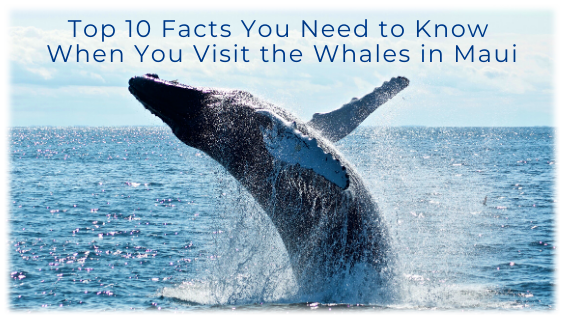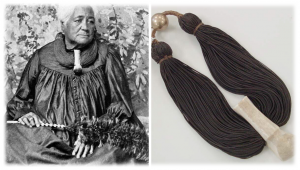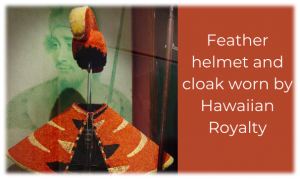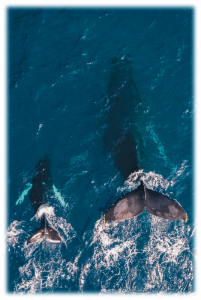 Whales Were Here Before People!
Whales Were Here Before People!
Graceful and awe-inspiring, the magnificent North Pacific Humpback Whales return to the tranquil waters of Hawai’i every year as they have done since 100/400 AD. A time before the first Hawaiians arrived.
The ancient Polynesians revered and held the whales as sacred beings.
Perhaps they may have been guided on their 2,700-mile voyage of discovery by these same stately mammals of the sea. Did they communicate with the ancients via dreams or visions? Unfortunately, we will never know what made these seafaring islanders get into canoes filled with plants, animals, and supplies and sail thousands of miles north to their new home.
Whatever the real story is, once you encounter these gentle giants up close, you will find yourself awestruck and mesmerized. You will never forget the slow-motion elegance and intelligence they possess.
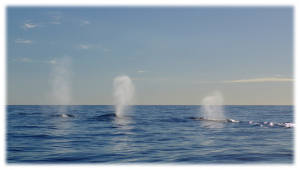
Their Hawaiian name is Koholā*. Their importance in Hawaiian culture is evident in the Kumulipo*. In this symbolic chant of 2,102 lines, the birth of the whale is stated in the second section, near the beginning of creation.
Hanau ka palaoa noho i kai — born is the whale living in the ocean
It was also believed that Koholā was the manifestation of the Hawaiian God, Kanaloa*. It is said that Kanaloa is responsible for helping the Polynesians arrive at their new home in the Hawaiian Islands. This is one of the theories of how early Polynesians first became aware of the existence of a distant land. Perhaps through a vision seen through na Koholā*, who were already swimming in these Hawaiian waters long before Polynesians decided to set sail.
Some legends even say the early voyagers followed a whale to the Hawaiian Islands.
Kanaloa is one of the four major Gods of traditional Hawaiian religion. He is the one we do not know much about. Besides whales and other sea life, we only know that he is associated with the ocean, long-distance voyaging, and healing.
Like all creatures of nature, whales were respected by the Hawaiian people. Their belief was that the gods would take the form of animals and plants and deserved respect. This practice is referred to in Hawaiian as kinolau*.
Koholā are also idealized as ‘aumakua* to specific families and were thought of as divine beings.
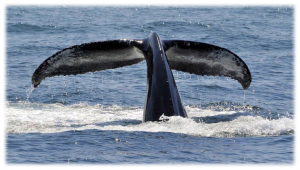
Ancient whale–tooth necklaces, called Niho Lei Palaoa* were worn by high-ranking Hawaiian chiefs, chieftesses, and the Ali’i*. It was thought to represent power and strength and served as a vessel for mana*. It was the second most valuable artifact an Ali’i could possess, the first being the mahiole* and ‘ahu’ula*.
 High Chieftess Mele Kaupoho with her Niho Lei Palaoa
High Chieftess Mele Kaupoho with her Niho Lei Palaoa
 Mahiole* and ‘Ahu’ula*
Mahiole* and ‘Ahu’ula*
To complete our story of how Hawai’i is connected to the whales, here is an ‘Ōlelo No’eau*
(Hawaiian Proverb)
O luna, ‘o lalo, ‘o uka, ‘o kai, ‘o ka palaoa pae, no ke Ali’i
Above, below; the upland, the lowland; the whale that washes ashore — all belong to the chief.
The chief owned everything in the land he ruled. Ivory obtained from the teeth of whales that washed ashore was very valuable.
As you can see, North Pacific Humpback Whales and their connection to Hawaiian culture and beliefs are deeply interwoven in Hawaiian legends and folklore. Some people still feel a powerful connection to the Whales and get out on the water as much as possible to be with them during Whale Season*.
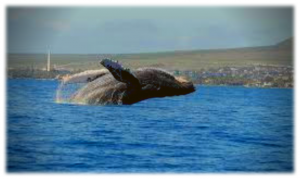
Top 10 Facts You Need to Know When You Visit the Whales in Maui
- Humpback whales do not actually have a hump. Instead, the name comes from what appears like a hump when they arch their backs before a deep dive. First, the arching back and then the tail. Once they dive, they will stay down for at least 20 minutes or more.
- Humpback whales depart the icy waters of Alaska in the fall for Hawai’i. They come to breed, give birth, and play. In Maui, the underwater visibility from the crystal clear water is exceptional. The variety of shallow (800’) and deep (18,000’) waters mixed with no natural predators gives them the ultimate safe space to raise and nurture their young calves in safety.
- Koholā have live births. Their pregnancy cycle lasts for about one year. Once the calves are born, they drink about 150 gallons of thick milk daily from their mother. They stay with her for a year.
-
Like a human fingerprint, each whale tail has distinct markings on the underside. These markings are used to identify and track individual whales so that we continue to learn more about them.
- The North Pacific Humpbacks are the fifth largest whale species on the planet and can grow to 60 feet long. They can weigh between 25 – 40 tons. This is longer than two London double-decker buses put together!
- As in most species of whales, female humpbacks are longer than males.
- They all have huge tails, some measuring up to 18 feet wide.
- They eat 2500 pounds of plankton, krill, and small fish twice daily. Their feeding season in Alaskan cold waters lasts for 120 days.
- There is nothing for them to eat in Hawai’i. They play, birth, mate, and then return to Alaska to eat in the spring. Only the calves will be fed by their mothers while they are here in Maui.
The male whales sing!
They perform these songs often during the mating season. Some believe the purpose of their songs may be to find their mate. Another belief is that it helps them to explore their new area. Get their bearings. When a male humpback moves to a new spot, he changes his song to match those coming from other nearby whales. We think they may be communicating with each other. Their song can be heard at a distance of 12 miles.
There is still so much to learn about these gentle giants.
You can see them and listen to their sweet song HERE
It is impressive that they travel back and forth from Alaska to Maui every year. The babies are primarily born in warm waters and grow sufficiently during the summer to be strong enough to be able to make the trip back to the cold waters of Alaska. Hawai’i is their sanctuary. Some go to the north side of Kaua’i, the north and south shore of O’ahu, and the Northeast part of the Big Island. As you can see here, the most significant area they frequent is around Maui and the smaller islands of Lanai and Moloka’i.
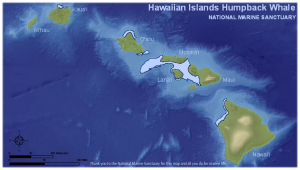
Here is the Hierarchical Order of Arrival to Maui
- The first to arrive are the mother whales who are nursing their calves that were birthed the year before.
- Next are the juveniles, adult males, and adult females.
- The last to arrive are the pregnant females. They come last because they feed and nourish themselves in Alaska until the very last minute.
North Pacific Humpback Whales have returned year after year to thrill people in Maui — locals and visitors alike. Each whale season is different. Some years there are record numbers visiting.
You can view them from the shore, on a boat, and they have been spotted from the helicopter ride on our Hana Sky-Trek.
Plan Your Visit to Come for Whale Season
On the water is one of the best ways to experience the whales up close. Be it on a boat, stand-up paddleboard, kayak, or inner tube. You can often hear their songs when you go underwater at the beach. There are so many whales singing during the season that it can sound like a whale cocktail party!
The magic of sharing the sea with these majestic and glorious fellow mammals is life-altering. So we hope you can join us on Maui for Whale Season.
And of course, adding the allure of the Road to Hana with Temptation Tours is another adventure that will cap the perfect Maui experience.
Writing and graphic creation by Sugandha Ferro Black
GLOSSARY* of Hawaiian Words
‘Ahu’ula – feathered cloak or cape was worn by ruling chiefs in Hawai’i
Ali’i – Aliʻi in the Hawaiian language refers to the hereditary line of rulers of the Hawaiian Islands.
‘Aumakua – Spiritual protector or ancestor
Kanaloa – the god of the sea, the divine and supreme Hawaiian demigod of ocean animals
Kinolau – the divine is everywhere, and everything is the divine, translates literally as many bodies, or every plant and animal is an embodiment of a god
Koholā – North Pacific Humpback Whales
Kumulipo – the Hawaiian chant of creation
Mahiole – feathered helmet worn by ranking chiefs in Hawai’i
Mana – divine power or strength, spiritual energy from the gods and their ancestors, the spiritual life force energy or healing power that permeates the universe
Maori – Polynesians from New Zealand, which is Polynesia’s largest island
Na Koholā – plural for whales
Niho Lei Palaoa – made of braided human hair and the ivory teeth of beached whales, an important symbol worn by the Hawaiian nobility to indicate their genealogical descent from the gods
‘Ōlelo No’eau – Hawaiian proverb
Petroglyphs – called kii pohaku in Hawaiian, are etched lava rock carvings from centuries ago by Native Hawaiians
Whale Season – November to May with peak time being January to March
*Please keep in mind that all Hawaiian Words have many meanings. The meanings we share here are the specific translations for the words as they pertain to this particular blog’s subject matter.
Photos courtesy of paid-for or free sources unless otherwise noted.
Feather cape and Helmut – CC BY-SA 2.0 – Gary SIzemore/Wiki, Lei Palaoa CCO 1.0 DEED/Public Domain and High Chieftess Mele Kaupoko – Public Domain , Sanctuary map courtesy of NOAA
